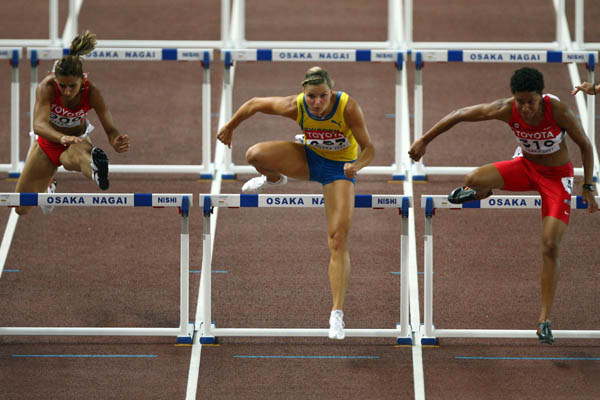On Saturday February 9, 2008 Susanna Kallur broke the world record in the women’s 60m hurdles with a 7.68 in Karlsruhe, Germany. Kallur’s world record can be sloughed off as not that big a deal because, after all, it is an indoor record and this is an Olympic year, so who cares about indoor records? But Kallur’s performance is yet another sign that the Americans are losing the battle of international hurdling supremacy, or at least losing their firm grip on the dominance they have shown in the past. Just like with Liu Xiang and Dayron Robles on the men’s side, Kallur’s technical proficiency seems to be giving her an advantage over her competitors and enabling her to create some separation. Whether she can carry her success over to the longer race outdoors remains to be seen, but the time to stand up and take notice is now.
A subtle shift is taking place in the short hurdling events – a shift away from a heavier reliance on speed and power, a shift toward a heavier reliance on technique. This is a shift that I certainly welcome, especially in the women’s race, where the hurdles are so low and the athletes so fast that technique is in danger of becoming irrelevant.
In the women’s race, speed provides much more of an advantage than in the men’s race because the hurdles are so much lower, but technique does factor in. Kallur’s arms are tighter than most women’s. She does have some side-to-side action with her arms between the hurdles, which causes a very slight twist in the hips when she attacks the hurdle, but it’s minimal. For the most part, her arms drive up and down, whereas a lot of women have a lot of lateral motion with their arms going across their body and, in some cases, raising up to shoulder-height during hurdle clearance. Kallur’s arms throughout hurdle clearance move almost in an entirely straight-up-and-down motion, and she gains power from the thrusting motion of her lead arm as she hammers it down when coming off the hurdle.

Kallur’s tight, thrusting arm motion serves to increase her forward momentum with each hurdle that she clears.
Another technical advantag of Kallur’s is her trail leg, which doesn’t pause, doesn’t lag behind, but drives forward and upward as soon it leaves the ground, which also minimizes any twisting in the hips. Her hurdling style – in regards to her lead arm and her trail leg, reminds me a lot of Xiang. The only elite American hurdler who matches Kallur in technical proficiency is Ginny Powell. If Kallur reminds me of Xiang, then Powell reminds me of Robles with the way she comes down on the hurdle. And Powell’s arm action is even more efficient and powerful than Kallur’s.

In this photo from the 2007 WC prelims, Kallur’s lead leg attacks the ground as the knee of the trail leg drives forward. Notice also the forward posture of her upper body, as well as the alignment of her hips and shoulders.
American female hurdlers over the past several years, such as Michele Perry, Joanna Hayes, and even going back to the days of Gail Devers, have primarily been speed hurdlers who rely on their extraordinary speed to compensate for technical flaws. For the most part, this approach has been very successful – to the point where it is tempting to say, the hell with technique. But it seems that an emphasis on technique by hurdlers from other countries has caused a closing of the gap that may well put an end to American hurdlng supremacy. On the men’s side, it has already happened with Xiang and Robles taking over as the world’s #1 and #2 ranked 110m hurdlers. On the women’s side, Kallur is leading the way toward a similar transition.

Ginny Powell here shows excellent hurdling technique. Note how, as a taller hurdler, she is able to look down on the hurdle. Notice too how Powell, like Kallur hammers down the lead arm and maintains forward alignment in the hips and shoulders.
As a coach, when I’m looking for athletes that I’d like my athletes to study, more and more often I find myself pointing them to foreign athletes. Simply put, the ones that I’ve mentioned in this article are doing more technically than most American hurdlers are. The American hurdlers might be stronger, faster, and in excellent condition, but, with very few exceptions, they aren’t technical masters. I mean think about it, Robles isn’t dominating the world indoor scene with 7.3’s every weekend because he’s faster than everyone else. Kallur didn’t break the 60m hurdle record last week because she’s faster than everyone else. When watching Kallur’s world record race I was impressed not just by her speed and power, but by the ease of it. And that’s what technical mastery does – it makes the difficult easy; it makes hurdling effortless.
© 2008 Steve McGill
****Click here to view youtube footage of Kallur’s world record 7.68.****
